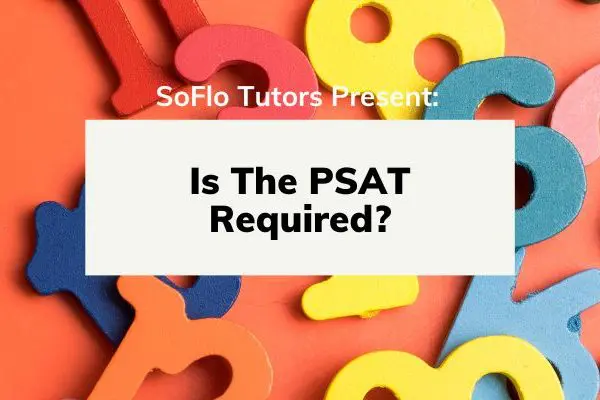
Most students will take the PSAT at one point in their high school careers. The PSAT is probably unlike any test you’ve ever seen or taken before. Its structure is unique in testing across major subject areas and the way that it’s scored is completely different than any high school test you might have ever taken. Before taking the PSAT, it’s a good idea to have a strong understanding of the meaning and purpose of the test. Read on to find out what the PSAT stands for and other crucial information to know.
What is the PSAT? The PSAT Meaning and Purpose
The PSAT is an exam primarily taken by high school sophomores and juniors to prepare for the SAT. Students can take the PSAT as early as the eighth grade if they are hoping to get a head start in preparing for college admissions, and you can only take the test once per school year. Schools administer the test, sometimes requiring all of their high school sophomores or juniors to take it, and they will usually designate a day for PSAT testing.
The PSAT is also a tool for schools to determine how prepared a student is for college. The exam asks questions in core subject areas of Reading, Writing, and Math and can measure how developed students’ skills are in each topic. The College Board, the organization who administers the tests, sets score benchmarks that indicates whether a student is on-track to be college ready. Students can compare their own scores to the benchmarks to determine if they are on the way to be adequately prepared for college.
What Does PSAT Stand For: The Abbreviation Explained
The PSAT stands for Preliminary Scholastic Assessment Test, or Preliminary SAT. This is because, as mentioned above, the primary purpose of the PSAT is to familiarize and prepare high school students to take the SAT.
The SAT is an important assessment for students planning to apply to colleges. College admissions committees factor in students’ SAT score when making admissions decisions, since it is a convenient and efficient way to compare academic performance in a standardized manner. Many colleges highly recommend submitting SAT scores in their applications, and some require it. SAT scores can also qualify students for various scholarships to help pay for college tuition. Therefore, the PSAT is a crucial preparation step for students hoping to take the SAT and do well.
Taking the PSAT is often the first step of SAT preparation as it is an invaluable opportunity to familiarize yourself with the format and structure of the test in a low-stakes format, since your PSAT score is not sent to colleges. It stimulates the closest environment to actually taking the SAT.
Is It The Same As SAT?
The PSAT is a preparation tool for the SAT, so the two tests share many similarities. They are structured the same, as both tests are divided into four sections: Reading, Writing and Language, Math with a calculator, and Math without a calculator. The question format is also exactly the same, as both tests ask questions in multiple-choice format, with four possible answer choices, and some grid-in questions.
There are also, however, differences between the PSAT and SAT. One major difference is the question content. Since the PSAT is taken by students in their junior year or younger, the question difficulty and content is scaled accordingly to grade level. Another difference is the scoring scale as SAT scores range between 400 to 1600, while PSAT scores range between 320 and 1520. Finally, the length of the two tests differs—the SAT is 15 minutes longer than the PSAT.
PSAT Test Types and Logistics
There are three types of PSAT’s offered based on your grade level: the PSAT 8/9, PSAT 10, and PSAT/NMSQT. Each test offers similar sections and types of questions, and they are all great opportunities to get used to the testing environment. There are minor differences between them, though, namely in question difficulty, time limits, and number of questions per section. Each test’s difficulty reflects the varying levels of knowledge between grade levels. The most popular test taken is the PSAT/NMSQT, and schools will often require their students to take this test and sometimes the PSAT 10.
PSAT 8/9
The PSAT 8/9 is taken by eighth graders and high school freshman and is offered by schools on several dates between September to April. Its sections include:
- Reading: 42 questions in 55 minutes.
- Writing and Language: 40 questions in 30 minutes.
- Math (calculator and no calculator sections): 38 questions in 60 minutes.
- Overall testing time: 2 hours and 25 minutes.
PSAT 10
The PSAT 10 is taken by high school sophomores and is offered by schools in February, March, or April. It is a bit longer than the PSAT 8/9, but is the same length as the PSAT/NMSQT. Its sections include:
- Reading: 47 questions in 55 minutes.
- Writing and Language: 44 questions in 35 minutes.
- Math (calculator and no calculator sections): 48 questions in 70 minutes total.
- Overall testing time: 2 hours and 45 minutes.
PSAT/NMSQT
The PSAT/NMSQT is taken by high school juniors and is the only opportunity to qualify for the National Merit Scholarship program (this is why this test is also called the National Merit Scholarship Qualifying Test—NMSQT). It is offered by schools in the fall. Its sections are:
- Reading: 47 questions in 55 minutes.
- Writing and Language: 44 questions in 35 minutes.
- Math (calculator and no calculator sections): 48 questions in 70 minutes total.
- Overall testing time: 2 hours and 45 minutes.
The National Merit Scholarship Program is an annual competition that gives out millions of dollars in scholarships to high-scoring students across the nation. These scholarships are highly competitive, as only scorers in the 0.5% of test takers in their state become National Merit Semifinalists, which is only the second stage of the competition. From this pool of students, only a select few become Finalists and receive scholarships. Note that students in 10th grade or below can’t qualify for the program.
What Each Section Of PSAT Stands For
Each section of the PSAT will test you on several skills in three main subject areas: Reading, Writing, and Math.
Evidence-Based Reading Test
This section tests your reading comprehension, command of evidence, vocabulary in context, and analytical skills by asking you questions based on a set of passages or pair of passages that you will be asked to read. These passages span several genres, from literature pieces and historical documents, to articles in the social sciences and natural sciences. This section name emphasizes that the test is “evidence-based,” meaning that your literary analyses must be grounded in evidence from the passage—the answers will not be subjective.
Writing And Language Test
This section tests your skills in the English language related to writing by asking you to edit passages that contain deliberate errors. You will be asked to correct grammar, word choice, and edit the paragraph for clarity. These passages cover topics in the humanities, social studies, history, or science and their complexity will vary.
Math Section With A Calculator / With No Calculator
These are two separate sections that will ask you to solve math problems that cover areas important to a variety of situations that will come up in your college major, career, and personal life. The section names are pretty self-explanatory: in the first section, you will be able to use a calculator, and in the second section, you will not be able to. There are four main types of math questions in the section:
- Heart of Algebra. This focuses on linear equations and systems.
- Problem Solving and Data Analysis. This focuses on analyzing problems and interpreting information from data.
- Passport to Advanced Math. This focuses on manipulating more complex equations.
- Additional Topics in Math. This focuses on problems related to statistics and probability.
Be Ready For The Exam With Our Tutors
SoFlo Tutors offers one-on-one tutoring with high school students across the nation preparing to take standardized tests. Our tutors attend top universities and scored in the 99th percentile on their SAT. They create tailored study plans and will work with you to increase your chances of getting your target score. Our tutors schedule sessions to your availability and our costs start at $60/hour. Check out our tutoring services to book a session!
About the Author

Andie Pinga is an expert SoFlo tutor and a senior at the University of Pennsylvania double-majoring in Economics and Anthropology. She scored a 35 on her ACT, and when she’s not studying on campus or meeting with friends, Andie enjoys playing the acoustic and electric guitar.










